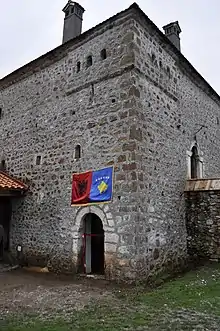Bujan Conference
The Bujan Conference was a political assembly held between December 31st, 1943 and January 2nd, 1944 in Bujan, a village in the Highlands of Gjakova. It was attended by 49 delegates from the Communist Party of Albania and the Communist Party of Yugoslavia. The organization of the conference was fueled by the main political goal among Kosovo Albanians in that era which was self-determination and reunification of Kosovo with Albania.The main resolution voted in Bujan called for the unification of the Socialist Republic of Albania and Kosovo after the end of WWII. The resolution of Bujan was abandoned after German retreat from the Balkans. Kosovo remained part of Yugoslavia, as an autonomous region of SR Serbia. The first uprising against the new Yugoslav regime began in late 1944, a few weeks after Yugoslav leadership made it clear that the unification of Kosovo with Albania would not occur after the war.[1][2]

Background
The Bujan Conference took place towards the end of World War II, in which many ethnically Albanian lands were under Fascist occupation. Kosovo was also under the control of the Fascists, and although there was not much enthusiasm for Fascist administration, Kosovo Albanians preferred it to oppressive Serbian rule. Tito and the communists originally promised to let the people of Kosovo decide democratically whether they wished to be part of Albania or Yugoslavia, which led to the conference.[3]
The decision to organise the Conference was held during the VIth Council of the Party's Provincial Committee for Kosovo and Dukagjin (Sharri, 3-5 November 1943). Initially, the Conference was to be held in Drenica, but the military and political circumstances at the time were unfavourable. Other important decisions were made at this meeting, such as:[4]
- To form the Provincial National Liberation Council for Kosovo and the Dukagjin Plateau.
- Establish the Chief of Staff of the National Liberation Army and the Partisan troops for Kosovo and the Dukagjin Plateau.
- Change the name "Metohija" to "Dukagjin Plateau ".
The Bujan Conference was opened on 31 December 1943 at 19.00 by Xhevdet Doda, delegate of the Kosovar-Macedonian Brigade. He proposed a 7-member presidency as well as two record-keeping holders, and then the 3-member Mandate Verification Council was elected.[5] The conference took place within the Kulla of Sali Mani, a Bajraktar of the Krasniqi tribe of the Gjakova Highlands. 49 delegates participated in the conference. It was welcomed by Fadil Hoxha - commander of the Chief of Staff of the National Liberation Army for Kosovo and Dukagjin Plateau, P.Jovicevic - on behalf of the Communist Party of Yugoslavia Regional Committee for Kosovo and Dukagjin Plateau, Xhafer Vokshi - on behalf of the Anti-fascist Youth, Sabrije Vokshi - on behalf of the Anti-fascist Women's Front, Xhevdet Doda - on behalf of the Kosovar-Macedonian Brigade and Mehmet Bajraktari - on behalf of Krasniqi National Liberation Council.[6][7]
Resolution
The Bujan Conference would culminate with an ultimate resolution - Kosovo would be reunified with Albania. The following is an excerpt from the Conference:[3][8]
Executive: Mehmet Hoxha, Pavle Jovićević, Rifat Berisha, Xhevdet Doda, Fadil Hoxha, Hajdar Dushi, Zekeria Rexha.
Members of the Council:
Ismail Gjinali, Tefik Çanga, Qamil Luzha, Xheladin Hana, Halil Haxhija, Ismet Shaqiri, Adem Miftari, Ismail Isufi, Sabrije Vokshi, Veliša Mičković, Lubomir Canić, Abdyl Kerim Ibrahim, Spira Velković, Xhevat Tahiri, Ymer Pula, Et-hem Zurnaxhiu, Ing. Nexhat Basha, Ajdin Bajraktari, Bejto Šahmanović, Milan A. Mičković, Zymer Halili, Mehmet Dermani, Qamil Brovina, Gani S. Çavdarbasha, Sul B. Alaj, Shaban Kajtazi, Ferid Perolli, Haxhi Morina, Xhavid Sh. Nimani, Reshat Isa, Mehmet Bajraktari, Veli Niman Doçi, Rasim Cokli, Sadik Bekteshi, Jaho Bajraktari, Shaban Haxhija, Alush Gashi, Beqir Ndou, Xhafer Vokshi, Sima H. Vasilević, Enver Dajçi, Maxhun Doçi Nimani.Aftermath
The conference reflected the politics of Albanian Communists for self-determination and the attempts of Yugoslav Communists to strike a balance between Albanian and Serbian Communists. Tito's first response to the conference was cautious and he called for postponement of a final decision. In an effort to gain popularity in Serbia, the Yugoslav Communists abandoned the resolution of the conference altogether. An uprising against the Yugoslavs in Kosovo followed. In 1945, Kosovo was designated an autonomous region of Yugoslavia within the borders of the Socialist Republic of Serbia.[9]
Bibliography
References
- Kelmendi, Ilir (May 2, 2018). Bujan Conference – Hope for the Realization of Historical Right on National Unification. Gjakova, Kosovo: University of Gjakova. doi:10.2139/ssrn.3172070. S2CID 233765502. SSRN 3172070.
- Gjeçovi, Xhelal (30 December 2007). MESAZHI I KONFERENCËS SË BUJANIT. Tirana.
{{cite book}}: CS1 maint: location missing publisher (link) - Elsie, Robert. "1944: The Resolution of Bujan". albanianhistory.net. Retrieved November 20, 2021.
- Kelmendi, Ilir (May 2, 2018). Bujan Conference – Hope for the Realization of Historical Right on National Unification. Gjakova, Kosovo: University of Gjakova. p. 2. doi:10.2139/ssrn.3172070. S2CID 233765502. SSRN 3172070.
- Gjeçovi, Xhelal (January 20, 1999). Rezoluta e Bujanit aspiratë e popullit shqiptar. Tirana: Historical Institute, Academy of Sciences of Albania. OCLC 45205469.
- Gjata, Rustem (1998). Aspekte politike e juridike të Konferencës së Parë të Këshillit Nacionalçlirimtar për Kosovën e Rrafsin e Dugagjinit. Prishtina. pp. 16–27.
{{cite book}}: CS1 maint: location missing publisher (link) - Rexhepi, Fehmi (1998). Vendimet e konferencës së Bujanit-Frymëzim për pjesëmarrje aktive të shqiptarëve të Kosovës në Luftën Çlirimtare Antifashiste. Prishtina. pp. 28–43.
{{cite book}}: CS1 maint: location missing publisher (link) - Këshilli Populluer i Krahinës Autonome të Kosovës-Metohis, 1943-1955. Prishtina. 1955. p. 10.
{{cite book}}: CS1 maint: location missing publisher (link) - Meier 2005, p. 25.
Sources
- Meier, Viktor (2005). Yugoslavia: A History of its Demise. Routledge. ISBN 1134665105.